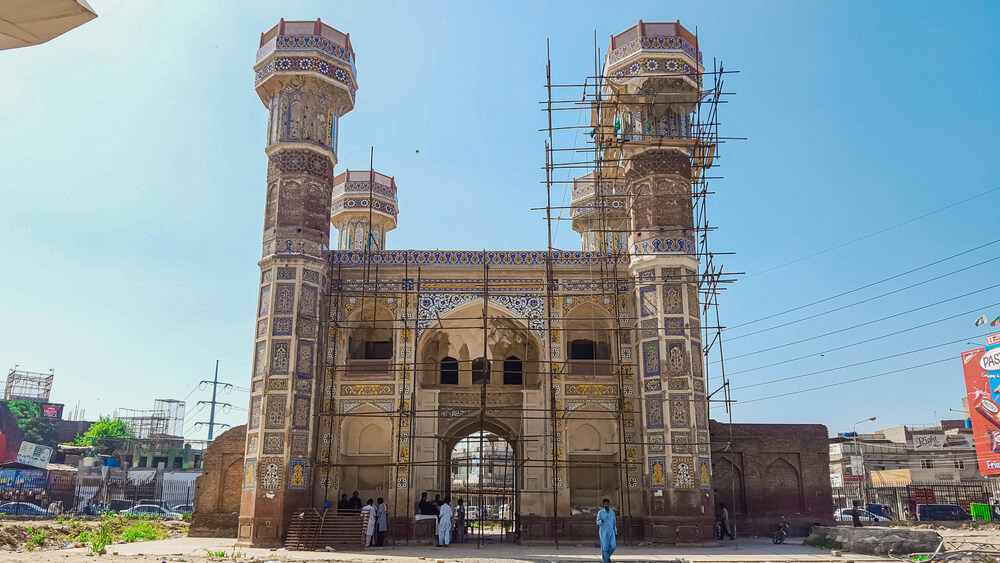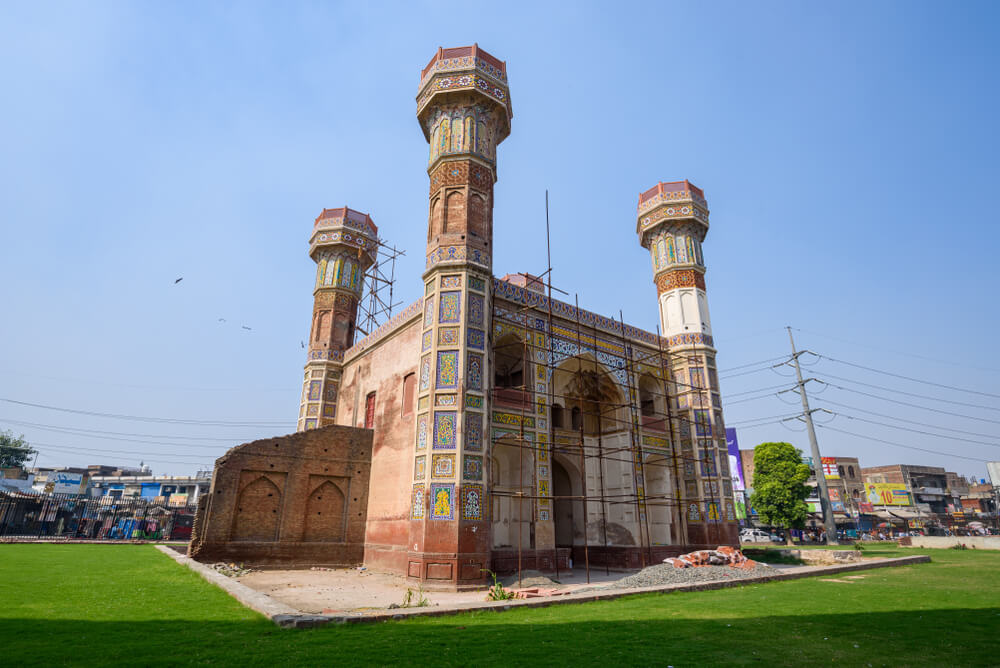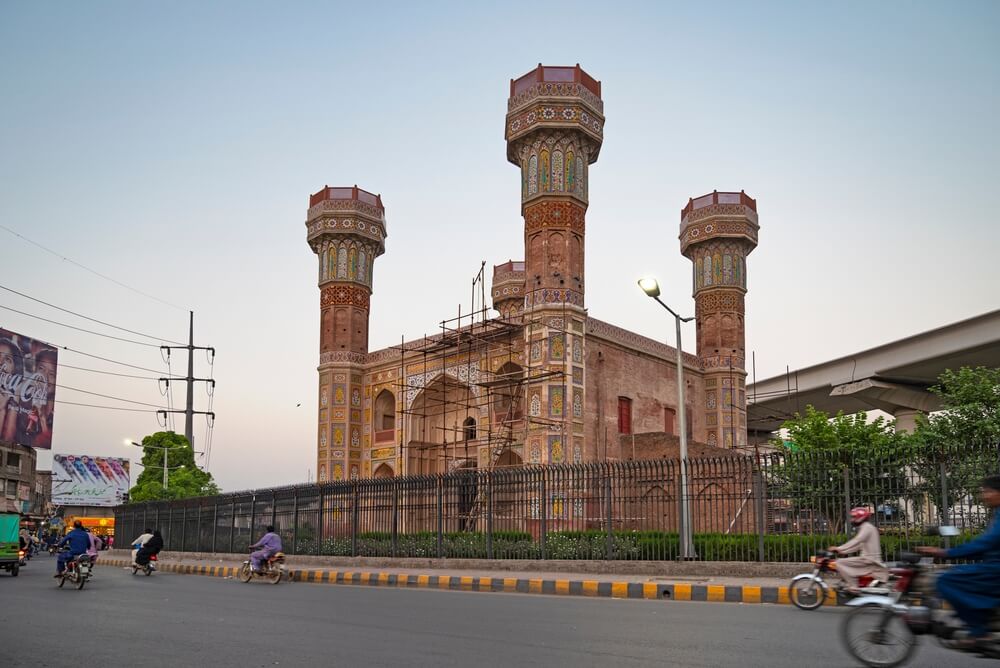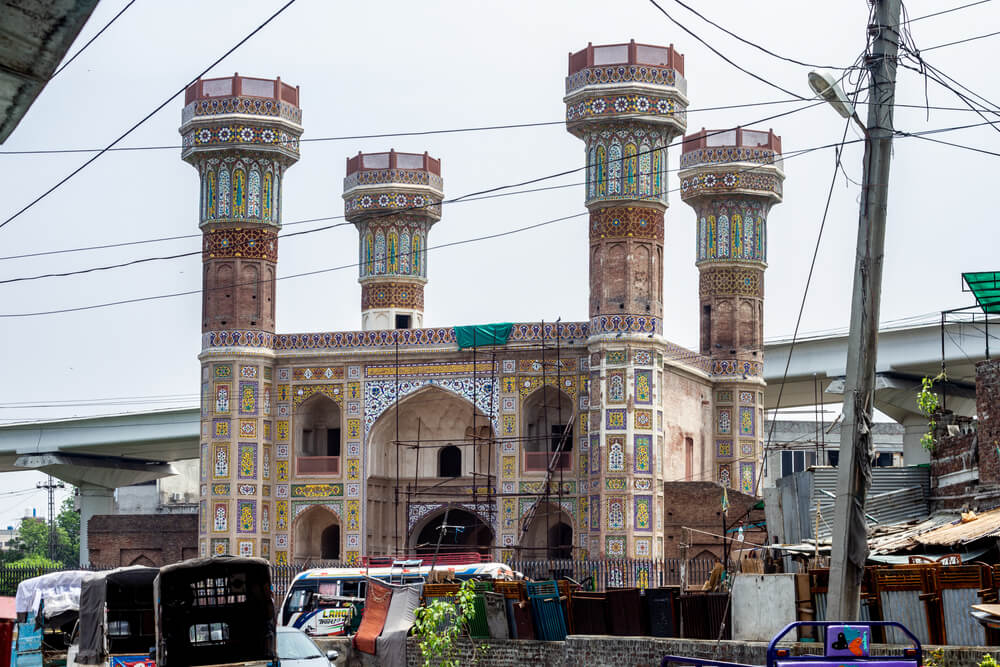Chauburji – Lahore
Chauburji, which translates to “Four Towers,” is likely most recognizable for its four full octagonal towers that rise against the building’s thick walls. It was formerly the gateway to a magnificent garden compound. Today, Chauburji is situated at a bustling junction where the highways to Multan and Bahawalpur converge. Though it appears to have vanished as the city has grown, a gorgeous structure is decorated with azure blue, lemon yellow, and sea-green mosaics inscribed with religious words.
If you’re ever in Lahore, be sure to check out Chauburji. It’s a beautiful Mughal-era building that’s worth a visit. The architecture is stunning, and it’s a great place to learn more about Pakistani history.
History of Chauburji
This garden is commonly attributed to the Mughal princess Zeb-un-Nisa, who is believed to be mentioned on an inscription as “Sahib-e-Zebinda Begam-e-Dauran.” At the time of construction, the princess was eight years old, so the description may refer to her aunt, Jahanara Begum, who was the daughter of the Mughal Emperor Shah Jahan.

Lost Mughal Garden
The garden for which Chauburji served as an entrance no longer exists. The structure is now in a grassy roundabout at the busy intersection of Multan Road and Bahawalpur Road in Lahore. It is said that the Mughal gardens reached from Nawankot in the south to Lahore city.
During Emperor Aurangzeb’s reign, most gardens are thought to have been destroyed by the Ravi river. Besides the Chauburji gate, no remnants of the previously large garden remain.
1960s Renovation
In 1846, a powerful earthquake caused the northwest minaret to fall and cracks to appear in the central arch. This has been repaired to the greatest extent feasible, and the doorway now resembles how it may have occurred during its Mughal patroness. In the late 1960s, the Department of Archeology of the Government of Pakistan performed the restoration.
Impact of Metro Development
The Chauburji monument is situated along the Orange Line of the Lahore Metro’s proposed itinerary. In breach of the Punjab Special Premises Ordinance, 1985 and the Antiquities Act of 1975, heritage activists filed a suit with the Lahore High Court because the planned metro line will pass near Chauburji, Shalimar Gardens, and nine other monuments in the city.
In August 2016, the Court banned the construction of the metro within 200 feet of any heritage property, including Chauburji, to prevent what UNEdescribed called potentially “irreversible damage” in areas where the line was to be built in its current form. The Chauburji station was modified from an underground to an elevated design to meet UNESCO requirements.
Architectures of Chauburji
The architectural style of Chauburji is a synthesis of Mughal, Timurid, and Perso-Arabic influences from the Middle East. Its top-widening minarets distinguish it, a phenomenon found nowhere else on the subcontinent. Some claim that these minarets once included cupolas that have since crumbled over time.
The structure’s eastern and western facades are adorned with two-story Timurid-style iwans flanked by two-story alcoves in the Shah Jehan period style of Mughal architecture. The system was decorated with elaborate blue and green Kashi Kari (or Kashan-style) tilework and frescoes. The Muqarnas was initially introduced to the Mughal Empire from Persia with the construction of the Wazir Khan Mosque in Lahore.

The building’s red brickwork is typical of Muslim architecture on the subcontinent, and the entrances and windows lining the inner corridors represent the Mughal architectural style. Although most of the inscriptions on Chauburjia have been obliterated, Ayat-ul-Kursi is visible in Arabic calligraphy in blue and porcelain on the structure’s highest point.
It has been argued that the architecture of the Charminar in Hyderabad, India influenced that of Chauburji.
Attractions at Chauburji
Here is the list of attractions that will encourage you to visit this place. So, if you are interested, read on!
Four Minarets
Architects and historians assert that the minarets, which extend from the summit and are not found anyplace else in the subcontinent, are among its distinctive features.
This monument has been the subject of several investigations to determine its extraordinary and distinctive characteristics. It is also thought that cupolas once adorned the minarets, which have since collapsed and have not been restored. This monument also features the red brickwork typical of Muslim architecture on the subcontinent, which can be found in practically all Mughal-era structures.
Rich Mosaic Decorations
Chauburji is a beautiful relic of Mughal architecture and is distinguished by its rich mosaic decorations. Chauburji comprises four octagonal towers, each adorned with intricate floral and geometric patterns.

The mosaics’ vivid colors and delicate details make Chauburji a truly stunning sight. Although the monument is no longer used for its original purpose, it remains integral to Lahore’s history and culture. Visitors to Chauburji can admire the beauty of the mosaics up close and learn about the rich heritage of the Mughal Empire.
Brilliant Tile Work
Chauburji is a beautiful example of tile work from the Mughal era. The tile work is brilliant, and it’s incredible to think it was created so many centuries ago. The colors are still vivid, and the patterns are intricate and detailed.
It’s no wonder that Chauburji is one of the most popular tourist attractions in Pakistan. Every year, thousands of people come to see the Chauburji, and it’s easy to see why. The tile work is simply stunning, and it’s a great example of the skill and artistry of the Mughal craftsmen.
Mughal Buildings’ Styles Doorways and Windows
You will enjoy the appearance and feel of the monument’s entrance when you reach it. The doors and windows lining the internal corridors represent the Mughal architectural style.
It is adorned with frescoes and calligraphy, and if you look attentively, the entrance of the gateway is reminiscent of the great Wazir Khan Mosque. With time, lack of upkeep, neglect, and weathering, the monument lost most of its inscriptions, but Ayat-ul-Kursi is still visible on the structure’s highest point (Quranic verses). Other notes on the memorial include two Persian couplets located above the arch.
The northwestern minaret collapsed during an earthquake in 1843, and cracks appeared in the central arch. In the late 1960s, the Department of Archaeology renovated it.
Grave of Begum Fakhrun Nisa
You will reach the Samanabad Mor intersection as you drive along Multan Road. The tomb of Zeb un Nisa, a Mughal from the 17th century, is concealed among stores, so you may walk by without finding it.
It is preferable to inquire with a local regarding the tomb’s location. The eldest daughter of the Mughal emperor Aurangzeb Alamgir was Zeb un Nisa, whose name meant “most lovely of all women.” She existed between 1637 and 1702

According to certain historians, the tomb generally known as the tomb of Princess Zeb un Nisa is the grave of Mian Bai, also known as Fakhr-un-Nisa, who was given the Chauburgi garden by Jahan Ara, the daughter of Shah Jehan.
In addition to the Chauburji garden, she was entrusted with the care of the Mughal garden in Nawankot, and she was buried in this tomb in Lahore upon her death.
Chauburji ticket price
There is no ticket fee for visiting Chauburji.
Chauburji Timings & Visiting Days
You can visit any time of the day. This monument is open to the public 24/7.
Location of Chauburji
Address: Block B New Chauburji Park, Lahore, Punjab 54000
Conclusions
Due to its historical, architectural, and cultural significance, the Chauburji monument must be preserved and maintained as a legacy of a beautiful past. It reminds me of the time when women’s talents and contributions were appreciated and celebrated. A trip to Lahore is incomplete without seeing this landmark and paying respects to Jahan Ara, the Princess of the Universe.
FAQs
What is Chauburji?
Chauburji is a historical monument located in Lahore, Pakistan.
Who built Chauburji?
The monument was built in 1646 during the reign of the Mughal Emperor Shah Jahan. Chauburji is one of the few remaining examples of Mughal architecture in Lahore.
Why is Chauburji called Chauburji?
The monument gets its name from its four minarets, a distinctive building feature. Each minaret is adorned with an umbrella-like structure.
Which Mughal Emperor built Chauburji?
The monument was built during the reign of Shah Jahan, the fifth Mughal Emperor.
What is the location of Chauburji?
The monument is located near Multan Road in Lahore, Pakistan.
How to visit Chauburji?
The best way to visit Chauburji is by hiring a local guide. The monument is open 24/7 to the public, and there is no entrance fee.
